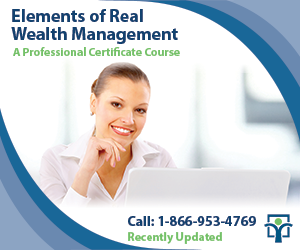Last updated: February 07 2017

End-To-End Advisor-Client Experience Important
The RRSP deadline for those making contributions to reduce their 2016 tax liability is fast approaching: midnight March 1. It’s important to get this done on time as a good Plan A, but also, to do so in conjunction with a long term financial planning outlook, as an even more important go-forward plan.
Working with a Real Wealth Manager can help. Real Wealth Management (RWM) is a strategic framework for making the best joint decisions about your investments with your advisor. It relates to four elements in the tax efficient financial planning process: how to Accumulate, Grow, Preserve and Transition sustainable family wealth; that is, with the most purchasing power: after taxes, inflation and fees.
As it relates to your advisors, this requires deep and broad knowledge across a spectrum of financial disciplines to help you make sound investment decisions with and for your family. In providing these skills as part of his or her service to you, the Real Wealth Manager elicits trust through a robust value proposition, that includes a well understood and consistent process you agree to. It’s a great way to bring purpose and structure to your regular meetings about reaching your financial goals.
What’s important about this process is that your financial progress is measured by analyzing three common financial documents (the personal and family net worth statements, the family tax returns and financial plans that encompass short term, near term and long term objectives). It also provides a method for consistent evaluation to ensure objectives are being met: in essence the earning of adequate after-tax income to enable the accumulation, growth, preservation and transition of capital. What’s important, is what you keep over time, and what it’s worth when you need it.
 |
Real Wealth, defined as what you have left after tax, after costs and after inflation, is the real value of the money you have to work with —purchasing power— that funds both needs and wants to make up the quality of your life in retirement. It’s what you are really interested in, at the end of the day. Therefore, you and your advisors (tax, financial and legal) must focus on strategies to minimize taxes and costs. This can include investment fees and interest, for example, but in addition, professional fees including legal and accounting fees payable over your lifetime. The conversations you have should anticipate the long-term impact of inflation (or deflation) and taxes on your assets in order to effectively manage and minimize risk to your portfolio.
Therefore, in planning a tax efficient approach to planning sustainable family wealth, your advisors will want to look at several factors:
- Triggers that cause financial decision-making: what are the needs and wants, specifically and behaviorally, that will drive financial decision making in the family as it relates to three triggers: life events (births, deaths, marriages, divorces, disability, etc.), financial events (employment bonus, job termination, should CPP be taken early or late?) or economic events (currency, inflation, political changes, other Black Swan risks).
- Eligibility for investing: For registered accounts, determine whether the investor is at least 18 and resident of Canada (TFSA eligibility), under age 72 with unused RRSP room of the prior years (RRSP eligibility), under 60 and disabled with a Disability Tax Credit (RDSP eligibility), etc.
- Availability of funds for investing: Will money be transferred from non-registered to registered accounts? Will money be borrowed to invest? What are the tax consequences? What are the repayment terms?
- Planning horizon, including age to retirement: This includes you, your spouse and all members of the family.
- Marginal Tax Bracket and Proximity to Clawback Zones: In creating tax efficient income levels, understanding how to “top up to bracket” to minimize taxes during your lifetime, as well as how to structure income sources to stay out of clawback zones is important. (Dividend gross-ups in non-registered accounts, for example, will increase net income, which may affect the size of refundable tax credits like Canada Child Benefits or social benefits like Old Age Security).
Therefore, a sound objective-based investment strategy must be developed that guides all the stakeholders to your Real Wealth Management Plan. It needs to include selections of investments that fill gaps in tax preferences available to each family member, based on age and other restrictions, and a plan for tax efficient income and capital available to each in the future.
Consider the brief investment checklist below for each family member, as strategies around the tax efficient accumulation, growth, preservation and transition of wealth dominate the RRSP transaction this month:
| FAMILY MEMBER NAME: | BIRTHDATE: |
|---|---|
| REGISTERED INVESTMENTS HELD | NON-REGISTERED INVESTMENTS HELD |
|
> TFSA > RRSP > RESP > RDSP |
> Interest bearing > Dividend bearing securities – ordinary > Dividend bearing securities – capital gains > Other securities |
| NON-FINANCIAL ASSETS HELD | DEBT TO BE MANAGED |
|
> Real Estate > Business Assets > Insurance Policies |
> Deductible Debt > Non-Deductible Debt |
The newly published Elements of Real Wealth Management Program provides certification to advisors wishing to practice as Real Wealth Managers. For more information, call 1-866-953-4769 or click here. You can also try it risk free here.
Evelyn Jacks is President of Knowledge Bureau, Canada’s leading educator in the tax and financial services, and author of 52 books on family tax preparation and planning.





